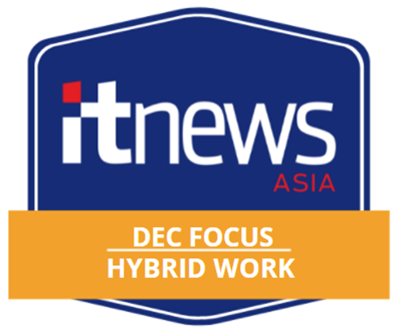
With hybrid work becoming more common, a key development in 2022 will be the transformation of the workplace in APAC. Every office is now doing a revamp to incorporate tech that better supports hybrid work.
What do you see as the challenges for organisations in adjusting to the new environment? How can they make changes to ensure work arrangements are flexible and yet remain secure, while enabling every employee, whether remote or in a fixed location, to equally participate?
In this month's special focus on hybrid work, iTNews Asia speaks with several players across the industry to hear their views.
Gaston Carrion, Managing Director – Talent & Organization / Human Potential, Asia Pacific Lead, Accenture.

What distinguishes workers from being healthy and effective, whether on-site or remote, is not the lack of negative stressors in their lives, but rather their abundance of resources, at both the individual and organisational level.
Organisations must look to provide employees with the resources to be productive anywhere. The focus must not be just about location, but address what drives the productivity, health and resilience of employees— including providing the right collaborative tools and skills.
Beyond that, increasing workforce health and resilience can be done by investing in healthy employees, relationships and work environments. This means paying attention to day-to-day changes, and empowering teams to shape their own change experiences.
Organisations can start by redefining work policies and strengthening worker-employer relationships with strategies that ensure workers are better off. Work must be designed around people and companies that support psychological and physical safety will foster trust. Building digital fluency will lead to higher growth and better places to work.
In 2022, the key to hybrid work success will be ensuring a vibrant corporate culture and empowering employees to stay productive anywhere by upgrading the access to company resources, enhancing flexible working arrangements and uplifting workplace digital capabilities.
Samir Bedi, Partner, People Advisory Services, Ernst & Young Advisory

In the COVID-endemic mode, more employees may be allowed to return to the office. Yet it is clear that we will not have the same masses of employees in the workplace. Today, top talent seek flexible working – not just where they work but when they work.
To attract and retain the skills needed and win this war for talent, flexibility in the workforce strategy is key. Workforce planning, which used to focus only on the quality and quantity of skills required, now involves determining where the skills should reside and whether the job can be done remotely.
Companies also need to determine which activities that can be performed remotely, and which needs to happen in the office setting. Importantly, instead of being the anchor where work is performed, the role of the workplace will evolve to that of a magnet – bringing people together for discussions while the execution is done elsewhere.
Beyond flexible working, another concern is that corporate culture could be diluted as employees work remotely. Hence, companies should rethink and reinforce their communications on culture, values and purpose, as alignment with personal values is important to today’s talent.
Sam Higgins, Principal Analyst, Serving Technology Executives, Forrester

Unfortunately for APAC workers, we predict that only 40% of firms will make anywhere work permanent, compared with 70% globally in 2022.
We see three challenges facing the region that are forcing organisations to bring most workers back to the office full-time:
Firstly, around one third of workers in the regions’ large manufacturing sector can adopt a hybrid model.
Then there are the outsourcing firms with purpose-built secure campuses and high-availability facilities who can’t provide the same level of service in remote locations with poor infrastructure.
Finally, there is what workers themselves want and in APAC 65% of information workers are eager to return to the office. Why? High-density extended-family living which accounts for the 58% of workers in the region say they’re less productive working at home, compared with 46% globally.
Regardless, the key to success is to set clear expectations such as punctuated office attendance for creativity and collaboration but combined with technology that ensures experience parity for both in-person and remote workers such as more collaboration spaces which connect the analogue inside to the digital outside world.
Krishna Baidya, Director, Information and Communication Technology, Frost and Sullivan

Our research found 93% of business leaders expect 25% or more of their employees to work from home. The ability to ‘liberate’ work from its traditional boundaries and take it anywhere offers unprecedented opportunities. Organisations are trying to fine-tune how they keep employees connected, engaged, and continuously learning while balancing productivity and well-being and making hybrid work sustainable.
The challenge is to ensure a consistent and seamless user experience for every user. The proliferation of distributed work is among the top factors causing organisations to re-think their physical space. To be successful, they must design for specific spaces and use cases yet be agile while implementing.
The foundation for hybrid work needs to be built on a collaborative fabric that patches the distance between the physical and virtual worlds – teams glued together by next-gen collaboration tools and capabilities allowing people to create, consume, and act upon critical information.
Investments should focus on digital and cloud complemented by a drive to automate processes and communications. The future workplace should support employee wellness as much as it focuses on business growth and productivity. Old workplace policies also need to be updated to align with the demand for new ways to work.
Yvonne Teo, Vice President – HR, APAC at ADP

Pre-pandemic, we had a largely centralised location – the office – to focus our management and leadership efforts. Now, as we’ve discovered from two years of working from home, supporting a dispersed workforce requires more initiative and creativity.
To support greater flexibility, many companies are accelerating their digitalisation efforts by adopting mobile apps, cloud software, and automating processes. In addition, employers must keep in mind that digital inclusivity is just as important as digital transformation itself.
Regardless of location, every employee should have access to the necessary equipment; digital tools that are easily accessible, and regular training to keep up with a rapidly transforming workplace.
Workforce visibility during remote work will also pose a challenge. Supporting a socially distanced team places adds pressure on managers, while employees may be anxious about not getting recognition for their contributions.
To combat this, teams should establish clearly defined processes and expectations, which can be supported by a data-driven workforce management strategy. Measurable indicators of performance, time and attendance, or even employee satisfaction, can help managers identify and address areas for improvement in the employee experience.
Dr Derek Wang, Singapore General Manager, Alibaba Cloud Intelligence

One of the key differences between an average home office and a professional office is the availability of the IT system and support. If certain IT functions such as database, CRM or intranet can only be accessed within office premise due to compliance or security reasons, businesses will not be able to bring a seamless and secure remote working environment to employees.
Therefore, it is important for businesses to look to the cloud rather than on-premise IT, to create an elastic, scalable and secure hybrid working environment that can accommodate various functional needs.
To support the future workplace, enterprises should be prepared to embrace an “office in the cloud” solution such as all-in-one PCs. The cloud computer serves as a bridge to connect traditional PC’s functionalities with a Cloud workplace, enabling users to access organisational resources regardless of where they are, as well as make remote working both feasible and efficient.
The biggest and most immediate hurdle is not just embracing these technologies, but reframing our mindsets – to welcome change as a first step.
Terry Smagh, Senior Vice President, Asia Pacific at BlackLine

With the inexorable shift to hybrid work, organisations need to recognise that employees will be removed from their comfort zone, possibly resulting in uncertainty and lower productivity. Leaders need to lead their employees through change and make concerted efforts to continuously engage them to understand their concerns and come up with clear guidelines.
It is also important to continually elevate the skills of each individual to keep up with the digital shift. Employees should have access to further learning and development opportunities through structured training programs. Leaders should work with IT and HR to provide and simplify digital platforms so employees can easily access training resources including support for mental wellbeing, which is becoming a big concern as work and life merge.
Companies can make hybrid working accessible by introducing cloud-based solutions. Some of the benefits include being able to access from anywhere anytime, collaboration and security. Any upgrades are made automatically by the cloud-solutions provider, who is also responsible for back-up, cyber security, disaster recovery and support services. This helps free up resources to support other areas in the organisation.
Jonathan Jackson, Director of Engineering at BlackBerry

Overall, companies are not yet ready to fully embrace hybrid working. The enterprise attack surface has grown substantially over the past two years, as remote and hybrid working practices have become ubiquitous. Employees are now accessing corporate resources across multiple devices and from various networks, and while many have relied on VPNs and legacy anti-malware software, these measures won’t be sufficient to protect organisations in the long term.
Employees often use insecure workarounds to avoid cumbersome verification processes. Threat actors are getting smarter, more inventive and callous by the minute. These two trends mean providing a safe and secure work environment has become a major vulnerability for companies across APAC.
Enterprises should adopt a Zero Trust approach to cyber security, where users can’t access anything until their identities are verified; and provide a Zero Touch experience: transparent and frictionless authentication processes that make it easy for users to comply.
The next frontier of enterprise work will see the employee experience not only redefined but enhanced. Future-forward companies are showing us the way with virtual workspaces in the metaverse. Organisations should look to these key trends and new employee experiences as a reality for the future of hybrid work.
Bee Kheng Tay, President, ASEAN, Cisco

Hybrid work is a joint effort between IT, HR and facilities teams, who must ensure technology, culture and the physical workplace are aligned to produce the best outcomes. One such outcome is employee wellbeing. As we observe rising cases of burnout, collaboration tools built in partnership with people experts and supported by data analytics like Webex People Insights can help address employees’ wellbeing needs through personalised insights and actionable recommendations on the way they work.
Hybrid work must also be inclusive for all, and technology can help level the playing field for different people working under various circumstances. For example, voice optimisation and intelligent cameras in video conferencing can equalise the audio and visual experience for virtual and in-person attendees.
Underpinning these initiatives, cybersecurity must continue to be the foundation of hybrid work to ensure a smooth and seamless experience for users no matter where they are working from. One security model that will dominate 2022 is Secure Access Service Edge (SASE), which converges comprehensive networking and security functions to provide strong, secure edge-to-edge access, for a distributed workforce.
Andy Sim, Vice President and Managing Director, Singapore, Dell Technologies

Dell Technologies Remote Work Readiness Index revealed that while many employees in APJ expressed readiness for long-term remote work, there are still challenges. These include blurred boundaries between professional and personal lives, fears over job security due to limited employer interactions, and distance between colleagues given the lack of face time.
Successful hybrid work hinges on three imperatives: Leadership, Structure and Culture.
Leaders need to build trust with their teams and demonstrate compassion towards their workforce as they adjust to flexible work. One way is to adopt an outcome-based mindset and design a system where managers and team members can work closely together to optimise their productivity and tasks, no matter where they work.
Structure-wise, organisations must balance flexibility with regularity. Consider setting aside fixed days or hours in a week that are blocked for core meetings or team activities, while keeping the rest of the time flexible for employees.
Finally, culture-building must be deliberate. Organisations can create opportunities for employees to learn, innovate and collaborate with one another – for instance, by channelling budget dedicated for regular social activities, or exploring creative ways to make learning engaging for all.
Jess Ng, Country Head of Singapore and Brunei, Fortinet

Fortinet sees that most enterprises are moving ahead with a hybrid work strategy that allows employees to work at least part of the time remotely. When remote work was first mandated, businesses were exposed to various cybersecurity risks because workers were connecting to company systems from poorly secured home networks and devices.
However, success in a “Work-From-Anywhere” (WFA) model is when workers and their devices can move seamlessly and securely between office, home and mobile environments. This helps employees to securely connect to the company network anywhere while ensuring they have access to tools and systems to stay productive.
Organisations can provide a safe and secure digital workspace for employees by unifying a broad portfolio of zero trust, endpoint and network security solutions. At Fortinet, we also use a form of mesh architecture known as the “Fortinet Security Fabric” that delivers fully integrated security, services, and threat intelligence everywhere across the extended network. Remote work is here to stay, so it is crucial for companies to continue invest in technology to boost cybersecurity and provide a better remote working experience.
Ralph Tan, Head of Modern Workplace Solutions, Logicalis

A hybrid model is far more common in today’s work climate. However, what is appropriate for each business will depend on its context. Organisations will need to develop a plan that is sustainable for the business and prioritises the health and productivity of its employees. By providing the right collaboration tools, it enables employees to remain connected with internal and external stakeholders, and thrive regardless where they are.
With the hybrid work model here to stay, organisations will need to be nimble and agile in ensuring the coexistence of different types of employees. As some return to the office, we expect to see physical offices being equipped with collaboration endpoints and increasingly adopting hotdesking models with booking systems in place.
While adopting a hybrid working model sounds like the natural choice, transformation is never easy. A major challenge organisations face is where to start when developing their transformation strategy and the role of security in a post COVID world. There is a lot of uncertainty concerning the sort of investments businesses should embark on and if Capex or Opex will make more sense for the organisation.
Denise Miura, Vice President, Asia Pacific and Japan, Medallia

Amid the great resignation, understanding every moment of an employee journey ought to be the new gold standard. Companies need to get the HR program right or risk losing their talents. This marks the next phase in evolution of the workforce – a refreshed post-pandemic work life where employers’ expectations and evaluation of workforce practices need to evolve along with what employees need.
In planning for this new hybrid workforce where face-to-face interaction with colleagues is significantly reduced, mastering the art of listening will prove to employees that their voice is still very much valued, if not more.
Increasingly, companies are turning their customer playbooks inward to design and manage critical employee journeys, capturing real-time feedback. With the help of AI, data analytics and listening tools, actionable insights across journeys or moments can help companies act on each employee’s unique experience, proactively address his or her wellbeing, and unlock on-the-ground observations to continuously improve and innovate.
At the end of the day, an empathetic and people-centred workplace culture will shape an energised and motivated workforce.
Sharif Khan, General Manager of HR for Microsoft Asia

The past two years have radically shifted our approach to work. Microsoft’s recent 2021 Work Trend Index revealed that we very much want work to be more of a thing to do and less of a place to go, without compromising the closeness and familiarity of in-person connections. This “Hybrid paradox” has become a code that many organisations are trying to crack.
At the heart of it all, it comes down to fostering a culture of trust, having a growth mindset when defining new workplace norms, and creating an environment of allyship and inclusion as a bedrock for the hybrid workplace to function effectively for all employees regardless of location or time-zone. There are clear opportunities to invest in technologies that can assist in bridging the physical and digital divide and rethink employee experiences and engagements with new or existing talent in a hybrid setting.
Security should always be top of mind when having a dispersed hybrid workforce. A Zero Trust strategy will be crucial for organisations amid the IT complexity that comes with hybrid work.
It's clear that the more an organisation embraces and creates space to innovate employee experiences that are hybrid, the more competitively advantageous they are in attracting and retaining talent.
Shaakun Khanna, Head of Human Capital Management Cloud Applications Strategy for Asia Pacific, Oracle

As businesses start reopening in this new environment, the hiring and retention of skilled, talented people will remain a top priority – especially amidst the Great Resignation.
Oracle’s 2021 AI@Work survey suggests that 88% of the Asia-Pacific workforce trust robots more than people to get their careers on track, and 61% are more likely to stay with a company that uses advanced technologies like artificial intelligence to support career growth.
Employees in Asia-Pacific are hungry for new skills and turning to technology for help. Some questions businesses can consider are: Is your HR department using the latest technologies to find and evaluate job candidates? Can you promise employees they’ll have access to digital tools to enable them to equally participate and collaborate with teams around the world?
Workers have much different priorities now compared to before the pandemic, including the type of employer they want to work for and what they’re looking for in their careers, and businesses must take this mindset shift into account. Employers need to be more proactive about charting career paths for their most valuable employees, or watch on as they explore other opportunities.
Mark Weaser, Vice President, APAC, OutSystems

From heightened conversations around mental health at the workplace to organisations overhauling traditional metrics of performance (read: presenteeism), it is clear that employee expectations have evolved in the work-from-anywhere era. Giving employees the flexibility of choice in where, when and how they work simply means that the organisation must acquire the capabilities required to provide increasingly complex yet highly personalised experiences for their employees.
Organisations need to refocus priorities on internal digital transformation, and leverage technology and modern application software to boost employee experience (EX). Think custom-built digital onboarding experiences for remote hires, personalised candidate applications that optimise and automate hiring processes, or even employee portals that can work across hybrid work environments.
2022 will no doubt bring fiercer competition in talent attraction and retention, as highly skilled talent can now look outside of Asia Pacific for opportunities. It may have taken a pandemic for EX to get into the spotlight, but it would certainly take a lot less for organisations to realise how critical it will soon become.
Mark Jobbins, Vice President & CTO, Asia Pacific & Japan, Pure Storage

In hybrid or remote work environments, data is now spread across even more locations, from the on-premise servers to cloud platforms that house critical applications, to employee laptops in their own homes.
Organisations are also expected to intensify their digital transformation efforts in this landscape, leading to an explosion of even more data to store, manage and analyse. This can lead to increased data fragmentation and silos, which not only impedes innovation and productivity, but also makes organisations more vulnerable to cyber attacks.
As such, data management is central to an organisation’s IT strategy as they transition to a hybrid or remote work model. IT leaders must create a flexible infrastructure with secure, on-demand access to data and data services, and ensure that processes are in place to manage data growth and storage.
Organisations should also aim to consolidate all data, applications and infrastructure across different cloud environments into a single, cohesive management interface. Last but not least, it is important to implement cyber hygiene and governance practices, such as protected immutable backups and timely security software updates.
Claribel Chai, Country Manager, Singapore, Palo Alto Networks

In a recent Palo Alto Networks study, APAC organisations identified maintaining comprehensive security as the top remote access challenge when expanding work-from-home capabilities.
With many companies adopting hybrid work, the enterprise network becomes decentralised as most applications and users will be outside the organisation. Many companies also rely on multiple cloud services for their day-to-day operations.
However, current cloud-delivered security offerings provide limited application coverage and inadequate protection. This puts organisations at greater risk of misconfigured cloud storage, and is further exacerbated by the sheer number of systems that are now linked to cloud storage, which increases the potential attack surface.
A security model such as Secure Access Service Edge (SASE) can help to support the dynamic needs of the hybrid workforce. SASE is the convergence of WAN and network security services, like Zero Trust, into a single, cloud-delivered service model. It enables organisations to apply policy-based security and deliver secure access to the appropriate application, user or device, no matter where they are located. Using a single, consolidated end-to-end platform also affords organisations greater cost savings and reduced complexity.
Chong Yang Chan, Managing Director, ASEAN at Qlik

Thriving in a hybrid work environment requires significant collaboration between teams across a mix of physical and digital spaces. This is becoming increasingly challenging, especially with more employees dispersed further from offices. While leaders can start by educating teams on the importance of teamwork and introducing collaborative tools, it is vital to remind employees to use data to aid in collaboration.
Data sharing not only enables teams to draw actionable insights based on facts but also facilitates creative problem solving to help businesses thrive and adapt through constant change.
However, as data sharing becomes the norm, employees may become overwhelmed by it. This is where data literacy - an individual’s ability to read, understand, and apply data – becomes an important skill. Emphasis should be placed on upskilling teams and encouraging employees to critically assess and use data to make business decisions.
Organisations can begin by identifying their employees’ data literacy levels to formulate an effective training plan. Leaders and employees can also leverage readily accessible resources to help keep up with growing data demands, including those available for free through the Data Literacy Project.
Josep Garcia, VP & GM, Asian Growth & Emerging Markets (GEMs), Red Hat

In the past two years, businesses have stepped up to the plate, adopting technological solutions that have enabled an almost fully remote workforce to work from home productively. However, for those looking to transition to a hybrid workforce, existing norms and practices currently designed for either all-remote or all-in-person employees are insufficient in encouraging the new modes of collaboration needed.
Hence, the main challenge facing organisations lies in reshaping mindsets, technology usage and existing workplace practices to ensure an equitable, seamless hybrid office experience.
No two hybrid workplaces are the same, and for businesses to redesign their workplace into one that closely aligns with the needs of employees - the first step they can take is to adopt an open-innovation culture, or what we at Red Hat know as open-source culture, which encourages collaboration throughout the company, regardless of rank.
By providing employees close to the ground with the decision-making power to create a hybrid workplace they desire, it empowers them to initiate and iterate change rapidly from the ground up, as well as work together to find common ground in using existing technologies to better meet their needs.
Verena Siow, President and Managing Director, SAP Southeast Asia

While the nature of our work at SAP is progressively digital-led, one challenge we foresee with hybrid work is the digitalising of human touch that is present in our social interactions with customers, partners and colleagues.
COVID-19 has altered the world’s working norms by challenging us to re-examine the purpose of a physical office. The Work From Home experience has highlighted the need to transform the office into a strategic and work-optimised environment that suits the tasks of the day, be it team-building or a product demonstration.
A hybrid office boosts interpersonal relationships by fostering learning, sharing and enriches networking experiences that can hardly be replicated off-site. Although employees have the autonomy to customise their preferred working experience, organisations must maintain a robust internal communications channel to ensure thorough employee engagement, at all times.
Geoff Soon, Senior District Manager for ASEAN, Snowflake

Online tools such as cloud, data analytics, communication and productivity platforms are making the hybrid work model efficient. As technology enables this new work environment, business leaders in APAC must plan and carefully determine which tools suit their business best, guaranteeing that they are sustainable and support employees well, regardless of their location.
This is especially so for employees onboarded in a remote or hybrid setting. Companies need to learn to accommodate remote onboarding and promote a healthy hybrid company culture and employee experience. With the increasingly competitive job market, they also need to invest in upskilling and reskilling their workforce to keep pace with emerging technologies. Equipping employees with the right skills and training is crucial to retaining talent.
Companies also face the challenges of cyber attacks, given the acceleration of digitalisation. Alongside the adoption of online tools, they need to strengthen their data protection and cyber security policies by adopting cyber security best practices and leveraging secure data platforms, which will enable them to make data-driven decisions safely and thrive in the new world of work.
Sumit Bansal, Managing Director of ASEAN and Korea at Sophos

The hybrid work environment brought about by the pandemic has seen IT teams suddenly at the forefront of organisations. And, unsurprisingly, this has increased workloads for IT teams.
According to The IT Security Team: 2021 and beyond report by Sophos, 69% of businesses saw an increase in their IT security workload, 61% saw an increase in the number of cyber attacks on their organisations with 54% of IT teams feeling that the cyber attacks have become too advanced for them to deal with on their own.
The future of our work is hybrid, and we need to start thinking of how we can provide our teams with the safest possible environments to work effectively and efficiently wherever they are.
While security protocols such as multi-factor authentication and/or VPNs help users stay protected, cyber security best-practices must be exercised to extract the greatest value out of these tools. While working remotely, it is easy to let our guards down, therefore businesses must continue to foster cyber security awareness amongst employees through regular training to improve an organisation’s overall cyber-hygiene in this new era of hybrid working.
TC Gan, Vice President, Solution Engineering, Asia Pacific & Japan, Tableau

‘The shift to hybrid work has significantly changed how decisions are made and troops are rallied. A decision-maker at Optus sums this up to a T.’ The increase in online conversations has underscored the importance of using data to inform conversations - a scenario that was less likely to happen in a physical meeting room.
In adapting to this change, leaders need to put data in the hands of their employees to build clarity, focus, and agility. A YouGov survey we commissioned found that business leaders in the region who were deliberate in increasing their data use since the pandemic were more than twice as likely to report positive changes in workplace decision-making and communication than those that haven’t.
As work transitions online, leaders must tap on data as the common denominator to build trust within their team. This starts by first ensuring that analytics capabilities are integrated in everyday work tools, so everyone can access the same data and participate equally. Beyond that, they must build a high-trust environment – one where organisations trust their people, and people trust their data – so that both participation and security can be addressed without compromising one for the other.
Peter Quinlan, Vice President, Business Collaboration, Tata Communications

Hybrid work can only succeed if organisations enable effective collaboration for employees across the spectrum of activities and interactions needed to support their work and life. Unified communications and collaboration technologies will play a pivotal role in optimising employee workflow and productivity.
As organisations transform to support new ways of working, challenges they face include enabling new modes of working with legacy infrastructure, and implementing newer, more advanced collaboration tools, while maintaining a robust privacy, regulatory and cyber security posture.
They need to develop a solid hybrid work framework for each type of job role and user scenario, and the technology needed to enable it. More often than not, that will then be enabled through a cloud-based, digital collaboration platform. Modern cloud platforms offer a range of capabilities, and can be complemented with additional tools, managed services and traditional voice services.
Moving to the cloud doesn’t mean organisations need to compromise on management, visibility and control of their data and their user experience. There are many technology providers today that can help enable secure, consistent and engaging experiences for employees wherever they are, with scalability, compliance and ease of management for the organisation.
Ricky Kapur, Head of APAC, Zoom

There is no one-size-fits-all approach to a hybrid work strategy. It is crucial for organisations to set up transparent communication lines with employees from the get-go to arrive at mutually beneficial work arrangements built on trust.
Employers must adopt the right technology to create an inclusive work environment and equip teams with tools that enable the hybrid workforce. Virtual meetings will continue to be the norm no matter where you work.
With collaborative solutions like video communications platforms in place, employees are no longer limited to traditional office spaces but able to work where they feel most productive. This creates a ripple effect across the entire organisational value chain - happy and engaged employees produce better work, allowing organisations to maintain operational excellence.
Security must be a top priority for a hybrid workforce. Organisations should adopt technologies like multi-factor authentication and the Zero Trust approach to security to ensure that employees can get work done safely from wherever they are.
Trust and technology are cornerstones to a successful return-to-office approach, and set a secure foundation for hybrid workforces of the future.









